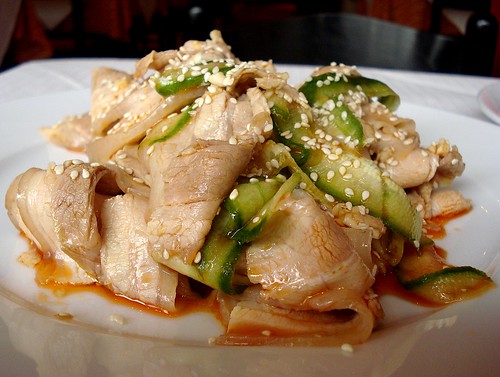The dish I'm posting about today comes from Xinjiang, the region of northwest China that I posted about on Monday.
大盤雞 (dà pán jī) is a Xinjiang dish which translates literally as "a big plate of chicken". This is a pretty good name for it, really — a single order of 大盤雞 (pictured above) feeds at least four people. Some restaurants may offer a smaller portion, 中盤雞 (zhōng pán jī/middle-plate chicken).
I posted an example on Monday of a menu in Xinjiang written in Chinese, English, and Uighur. One of the dishes on this menu is in fact 大盤雞, the Uyghur version of which ![[personal profile]](https://www.dreamwidth.org/img/silk/identity/user.png) pne has kindly transcribed for me as داپهنجى (he also points out that this is just a transcription of the Chinese name).
pne has kindly transcribed for me as داپهنجى (he also points out that this is just a transcription of the Chinese name).
I haven't managed to find a single authoritative-looking recipe for 大盤雞 (either in books or online), so please don't rely on the notes below being exactly accurate. The eGullet thread on big-plate chicken has some useful discussion, though.
I found two videos online showing 大盤雞 being prepared. The first was shot in a restaurant in Xinjiang. A whole chicken is cut into chunks on the bone with a cleaver, potatoes are peeled, leeks are prepared, and then various ingredients are shown in bowls, including the chicken, the sliced potatoes, sliced onions, chopped tomatoes, and chopped green chillies (I think). The chicken is initially fried along with a dark red paste from a tub which has a term on it that I can't quite make out, but it's four characters with the middle two being 油 and 豆. The stewing liquid added appears to be water.
The second video is one from 天天飲食, a daily cookery show from China Central Television. The ingredient list given is incomplete, but includes 三黃雞 (sān huáng jī/a type of chicken), 土豆 (tǔ dòu/potatoes), 青紅椒 (qīng hóng jiāo/green and red peppers), 麵粉 (miàn fěn/wheatflour), 朝天椒 (cháo tiān jiāo/"facing heaven" chillies), 乾線椒 (gān xiàn jiāo/some kind of chilli), 花椒粒 (huā jiāo lì/Sichuan peppercorns), 花椒麵 (huā jiāo miàn/ground Sichuan pepper), 紅油 (hóng yóu/chilli oil), 味精 (wèi jīng/MSG), and 鹽 (yán/salt). The chopped-up chicken is blanched in water, some sugar is caramelised, then whole peeled garlic cloves, sliced peeled ginger, and the white parts of spring onions are stirfried in oil. Sichuan peppercorns, star anise, and cassia/cinnamon bark are added and stirfried for a bit longer, then the chicken is returned to the pan along with the caramelised sugar, the two types of chillies, and some salt. Water is added, the chicken is simmered for a while, and then the sliced peeled potatoes are added. The chilli oil and red and green peppers go in later along with a brown powder and what I think is more garlic, chopped this time. The accompanying noodles are made from a simple flour/salt/water dough.
It's worth noting that when I tried making this according to the methods in these videos (and Sunflower's recipe mentioned below), my chicken ended up terribly overcooked. I may have over-fried it in the initial stages, but I do think next time I might give it some time out of the pan while the potatoes are cooking.
Given the large Muslim population in Xinjiang, I was initially confused by the inclusion of beer or Chinese wine in a number of the recipes for 大盤雞 I found online — for example Sunflower's 大盤雞, which uses beer for the stewing liquid. However, ![[personal profile]](https://www.dreamwidth.org/img/silk/identity/user.png) sashajwolf points out in comments that beer is not explicitly forbidden in Islam, and arguably neither is wine made from things other than grapes (and the type of Chinese wine used in traditional Chinese cooking is made from rice).
sashajwolf points out in comments that beer is not explicitly forbidden in Islam, and arguably neither is wine made from things other than grapes (and the type of Chinese wine used in traditional Chinese cooking is made from rice). ![[personal profile]](https://www.dreamwidth.org/img/silk/identity/user.png) pandarus adds in the same comment thread that it's actually intoxication which is forbidden.
pandarus adds in the same comment thread that it's actually intoxication which is forbidden.
The potatoes should be either sliced thickly or cut into chunks. The chicken should be cut into chunks still on the bone — just get the butcher to do this, unless you really love hacking carcasses about with a cleaver. (The chicken pieces should be small enough to be picked up with chopsticks, so you do want it chopped up, not just jointed.)
Garlic, onions, and fresh chillies are commonly mentioned in recipes. Some sources say that tomatoes or tomato purée should go in too, and possibly also some vinegar. Sugar appears in many recipes as well, with Yummy By Scratch even going so far as to caramelise the sugar first. Spices I've seen suggested include cinnamon, cassia, star anise, cumin, Sichuan peppercorns, and dried chillies; Sunflower also adds chilli bean paste (豆瓣醬/dòu bàn jiàng).
As mentioned above, if you're going to order 大盤雞 in a restaurant then you'll need at least four people to do it justice. One good way to eat the dish is to first eat all the chicken and potatoes, then to order some belt noodles (see Sunflower's recipe for how to make the noodles) which are placed in the remainder of the sauce to soak all up. Alternatively, you can soak up the sauce as you go along with the Xinjiang flatbread known as nan. This is similar to the Indian naan (it's leavened, and baked in a tandoor) but is circular rather than teardrop-shaped, and the centre is stamped flat before baking and often impressed with a decorative design (photo of stamped nan).




















